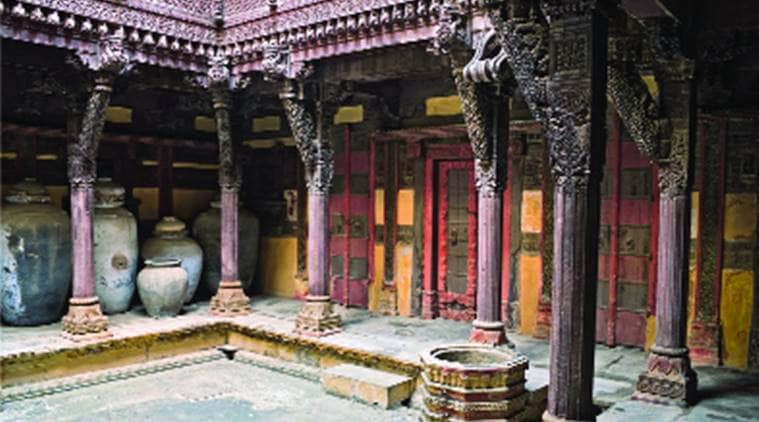A country that allows its craftsmen to die, is going to die soon: Architect Miki Desai
The Ahmedabad-based architect talks about 'vernacular' architecture, keeping in mind the country's limitations and people's plight instead of building symbols of falsehood, and his new book on the wooden architecture of Kerala
 A courtyard with a water tank in a traditional haveli in Vaso, Gujarat. (Source: Miki Desai)
A courtyard with a water tank in a traditional haveli in Vaso, Gujarat. (Source: Miki Desai)
For 40 years, Ahmedabad-based architect and retired professor of CEPT University, Miki Desai, travelled across India and South Asia to document sustainable architecture. Desai, 72, was in Delhi last week for his exhibition “From My House to Your House: A Select Journey of Indian Vernacular Architecture (Lok-Sthapatya)”, with 5,000 photographs, diagrams, and a playing-card deck, that highlighted the fast-disappearing aspects of sustainable “vernacular” architecture. Desai also spoke of the “intricate, structural carpentry” of Kerala’s temple architecture, which he delves deeper into in his recent book, Wooden Architecture of Kerala (Mapin Publishing). Excerpts:
What is vernacular architecture?
The pure definition, adhered to by many, is architecture done without architects. It is also where people themselves have made the buildings (village mud-houses, with local material); we are talking about craftsmen doing the buildings, but at the same time, the idea of architecture as a profession doesn’t exist. What exists are guilds, like carpenters’ guild, that constructs the buildings. Thus, it is a collaborative effort of craftsmen, rather than of a professional. Call them indigenous, instead of vernacular. What’s important is not the terminology, but what’s happening within it.
 Desai at the Delhi exhibition
Desai at the Delhi exhibition
What took you to Kerala?
Somebody from Switzerland approached me in the 1990s to contribute to an exhibition, “Ill? Why”. For my chapter on “Vows People Take to Get Cured”, I started looking at Indian temples and was directed to Kerala’s practice of nercha (vows) – taken to get cured, get a marriage done, etc. I’m a heathen, but there I became a devotee, for the only way to learn things is to participate. The temples were so different from what I had seen.
In what ways? Tell us more…
There are four types, in terms of shape: square, circular, rectangular, apsidal. Their spires could have four storeys and the wooden (double) roof craftsmanship could go as far back as 400 years. The temple architecture is similar to residential architecture. Within the temple (outer shell) is another temple (inner shell), the garbhagriha (sanctum sanctorum), where the main idol is enshrined. The visitation is unlike north Indian temples. You’re not allowed inside the garbhagriha, the domain of the Melshanthi or priest. The salutation pavilion is restricted to the Namboothiris (landed Brahmins). Outsiders can’t climb in; and there’s an invisible line which a Dalit wouldn’t cross.
 Miki Desai’s book jacket
Miki Desai’s book jacket
In your book, you describe the differences of an Ezhava house from that of the higher-caste Namboothiri or Nair. How does caste percolate into architecture?
Ezhava houses used to be meagre but now they have come up owing to economic forwardness, etc. The houses of Namboothiris are traditionally larger, more opulent, with multiple buildings, granaries, kulam (bathing pond), and temple – a whole samrajya – within the compound. The Nair (protectors) houses were smaller (than the Namboothiris), with a smaller courtyard. The houses of the Brahmins who came from Tamil Nadu are long, with a small ventilating (not activity) courtyard. They don’t believe in orientation and feel that since they are pure, their houses are good enough simply by their being in them. The kitchen would be located far away from the courtyards, unlike the ones in the “ventilating and socialising” courtyards of Gujarat’s pols and havelis. For the Kerala Brahmins (especially Tamil Brahmins), the kitchen is a sacred domain, which can get polluted by men, outsiders, menstruating women, etc. Sometimes, you find a well, half of which is outside and half in the kitchen. There’s a token gesture of the sacred and profane. Even from the outside, if somebody were to take water, they would do it carefully, knowing that it is the same water that will be used in the kitchen.
Himachal Pradesh’s kumbh (pot) column reappear in Gujarat, as do mythical Yali/Vyala of Kerala’s balcony brackets. How did motifs and style travel?
The idea of pan-Indianness must have been fairly coherent in the past, when transportation wasn’t what it is today. This country is full of diversity, and, yet, people from one part don’t know enough about another. I had studied architecture rigorously in Ahmedabad, studied Roman and Greek architecture but nobody taught us about Indian regional architecture. Nor do we make an effort to know or have value for what our neighbour is doing, so all this talk of national integration or one integrated image of the country is really a farce.
What about the drive to build statues?
We are a poor country and shouldn’t be spending colossal money like this. You are modifying the ecology, people’s lives. The bullet train, too, is displacing farmers.
The Central Vista redesign is facing a lot of flak. What makes Bimal Patel a winning bidder? Was he your student at CEPT?
He is well-connected. No, I didn’t teach him, but he used to be a good friend. To me, ‘modern’, ‘old’, ‘smart cities’ are not important words. We have to look at the necessities and plight of the people, and, in forging urbanity, keep our Indian limitations, ethos, culture, climate, materials in mind, rather than creating symbols of pride, of falsehood. A country that allows its craftsmen to die, is going to die soon.
- 01
- 02
- 03
- 04
- 05































